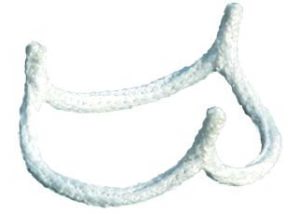
The Duke Children’s Pediatric & Congenital Heart Center (Duke University Medical Center, Durham, USA) treats the entire spectrum of patients with complex congenital heart disease. In this article, Cardiovascular News focuses on how the centre manages patients with congenital aortic valve disease—specifically, their use of the HAART 200 and HAART 300 (both BioStable) internal aortic valve annuloplasty rings.
Patients with congenital aortic valve stenosis may present with the typical trileaflet valve, bicuspid valves or even unicuspid leaflets. Joseph Turek, the executive co-director of the centre, explains: “These children are born with stenosis of their own valve [i.e. it is not acquired aortic valve stenosis]. Something happens during embryonic development wherein the valve did not develop to the right size. A lot of these patients end up having bicuspid or unicuspid leaflets as well.”
He adds that the management of these patients “has really advanced over the last 20 years or so, and the vast majority of institutions now offer balloon valvuloplasty. It is very effective”. However, a caveat of balloon valvuloplasty is that it can cause aortic valve insufficiency. According to Turek, “you have exchanged the problem of aortic stenosis with the problem of aortic valve insufficiency”. Therefore, the treating physicians at The Duke Children’s Pediatric & Congenital Heart Center face the challenge of managing patients with aortic regurgitation as well as aortic stenosis or those with pure aortic regurgitation. “We need to be able to address this challenge,” Turek comments.
HAART 300 and HAART 200

The Hemispherical Aortic Annuloplasty Reconstruction Technology (HAART) 300 and HAART 200* internal annuloplasty rings are a potential solution to this challenge. HAART 300 is for patients with trileaflet valves and the HAART 200 is for patients with bicuspid leaflets, and both were designed using mathematical analyses from human computed tomography angiograms (CTA) to ensure that they had the best anatomical shape. In Innovations, J Scott Rankin (Department of Cardiac and Thoracic surgery, WVU Heart and Vascular Institute, West Virginia University, Morgantown, USA) and others write: “Because the aortomitral curtain shifts with systole, both rings were machined in diastolic geometry, with the goal of moving the annuli centrally to recruit the leaflet for coaptation height.”1
Prior to the HAART devices, no devices were available for the management of aortic valve regurgitation that had been designed from the actual geometries of the aortic valve. Turek comments: “With the availability of the HAART devices, you now have something that is geometrically similar to how the aortic valve should be in a normal state that you can put in and allow you to facilitate the repair of the valve.”

While both devices were designed on the geometry of a healthy aortic valve, they do differ given they are for different patient subgroups. The HAART 300 is elliptical and is sutured just below the junctions of the leaflets and the aortic wall. The aim is to force the annulus of the native valve to conform to the normalised shape of the device. By contrast, the base of the HAART 200 is circular and has two subcommissural posts spaced 180 degrees apart around the circumference. It has a circular base because the presentation of bicuspid aortic valve disease varies and there is not a typical annular shape. Therefore, the aim of a circular base is to provide the best shape for reducing and stabilising the annular dimensions for all classifications while facilitating and simplifying leaflet reconstruction.
Benefits for the growing patient
According to Turek, a problem with leaflet-based repair procedures is that they become less effective as the paediatric patient ages. He says: “You can do all you want with the leaflets and get a nice repair. But with a growing child, the annulus grows as the aorta grows and you can lose the benefits of the repair because the annulus is not stabilised. So, this is the big advantage of the HAART 200 device. It stabilises the annulus and the hope is that this will translate to greater longevity of the repair.”
Another benefit of both devices is that they do not require the prescription of lifelong warfarin (as the implantation of a mechanical heart valve would do). The paediatric aortic valve disease cohort, Turek comments, represents a “very young, very active population that want to go out and do a whole bunch of activities”. Therefore, they do not want to have to deal with the limitations of warfarin (i.e. avoiding contact sports to avoid the risk of bleeding). Further down the line for female patients, a HAART 200 may allow them to have an easier pregnancy. If they were on warfarin because they had a mechanical valve, they would have to go through a transition period before becoming pregnant. “Hopefully with this device, we can get them through the child bearing years and also through the highly active, young, teenage years—a period of 20 years etc. from receiving the device. We want to get to the point at which a replacement device would not be beset with so many issues, such as the patient outgrowing the device or not wanting to take warfarin,” he says.
At present, there is published two-year data from the original HAART clinical trials.1 Additionally, there are multiple publications from the early commercial experience using the HAART 300.2–5 A report of four patients treated with the HAART 300 device showed good results at six months postoperatively (on 3D transthoracic echocardiogram).2 The report authors Jacek H Juściński (Department of Cardiac and Vascular Surgery, Medical University of Gdańsk, Poland) write: “The HAART 300 rings, thanks to their construction (rigid rings), permanently stabilise the atrioventricular junction and, as a result, facilitate the reconstruction of insufficient aortic valves, including the plication of cusps in cases of prolapse.”
Turek acknowledges the need for further studies of the devices to “see if their potential benefits will truly pan out and if we have will have better longevity with them”. But, he notes: “I think the early results are encouraging. I can say from someone who has put in more of the HAART 200 in paediatric patients than anyone in the world, I am very comfortable with it and I found the learning curve pretty easy. Its simplicity is a real benefit.”
References
- Rankin et al. Geometric ring annuloplasty for aortic valve repair during aortic aneurysm surgery. Two-year clinical trial results. Innovations 2018; 13: 248–53.
- Juściński et al. First uses of the HAART 300 rings for aortic valve repair in Poland—4 case studies. Kardiochirurgia I Torakochiurgia 2018; 15: 38–43.
- Russo et al. Aortic valve repair with a novel rigid annuloplasty ring. Cardiovascular Medicine 2018; 21(6): 160–64.
- Russo et al. Early clinical experience with double ring implantation for aortic and mitral valve repair. Thorac Cardiovasc Surg 2018. Epub.
- Jasinski et al. Aortic valve annuloplasty with the HAART geometric ring and ascending aorta replacement. Multimed Man Cardiothorac Surg 2018. Epub.
HAART 200 is investigational in Europe and is not available for sale












